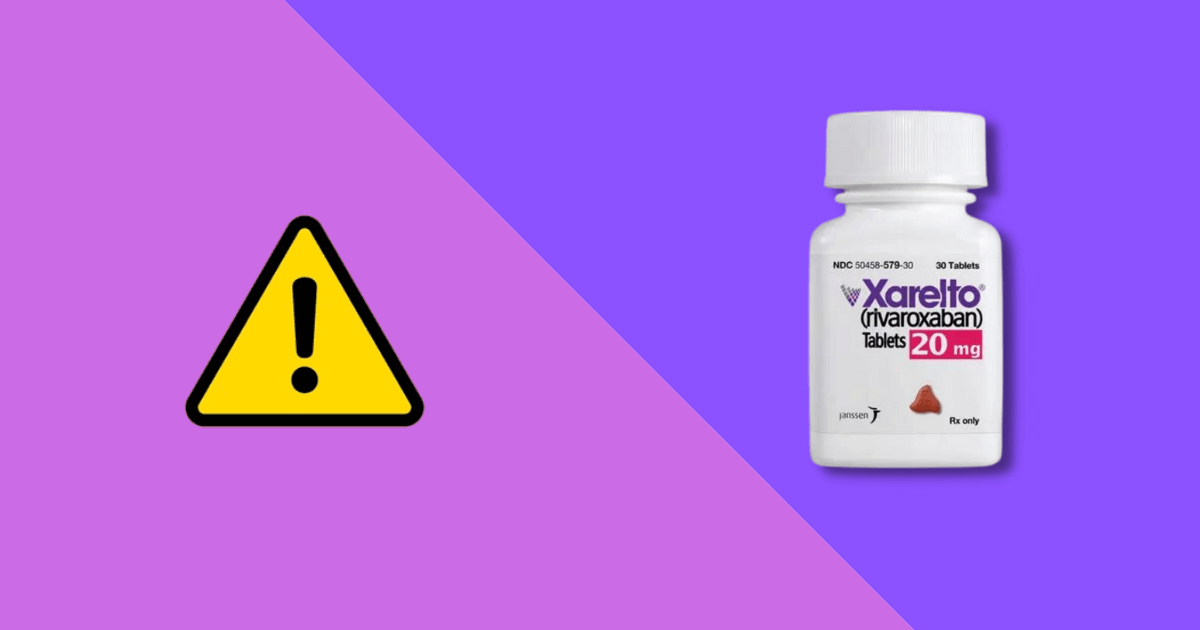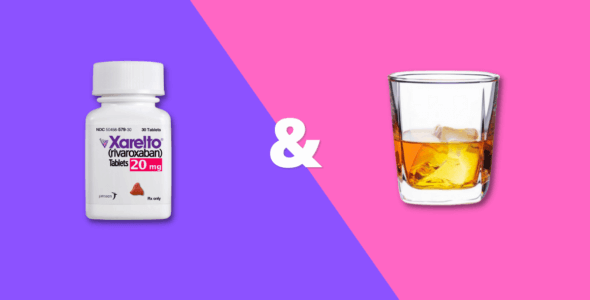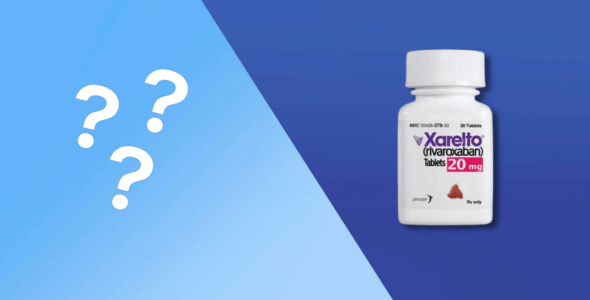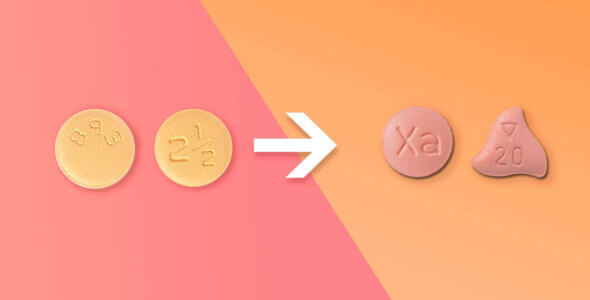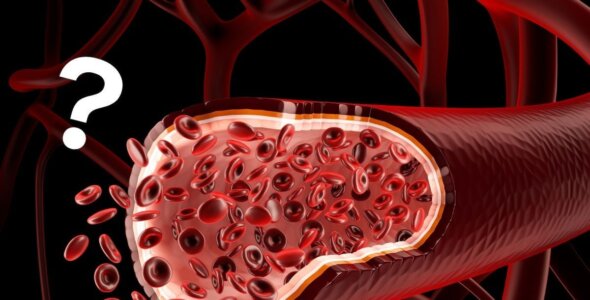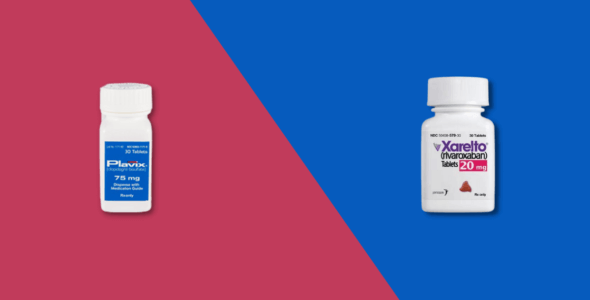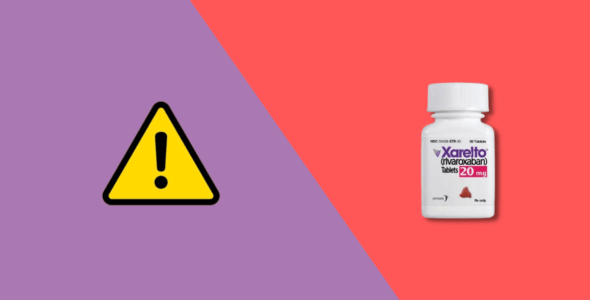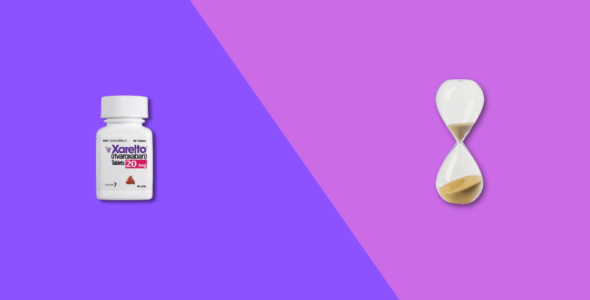Xarelto side effects and how to avoid them
Table of contents
Xarelto is a prescription drug approved by the U.S. Food and Drug Administration (FDA) to stop blood clots from forming. A blood clot is formed when some of your blood thickens and forms a gel-like plug in your body. It can block the flow of your blood, and in some cases lead to life-threatening conditions. Xarelto can cause adverse reactions like any other drug. Learn more about Xarelto’s side effects and how to avoid them.
What is Xarelto?
Xarelto is a brand name FDA-approved prescription blood thinner (anticoagulant) medication used to treat deep vein thrombosis (DVT) and pulmonary embolism (PE). It is used to reduce the risk of DVT and PE recurring. Xarelto belongs to a class of medications called Factor Xa inhibitors which reduce the chance of blood clots happening and also reduce the risk of coronary heart disease and peripheral artery disease.
It’s prescribed specifically to:
- Reduce the risk of stroke and blood clots forming in people who have a condition called nonvalvular atrial fibrillation
- Reduce the chances of a blood clot forming and causing deep vein thrombosis or a pulmonary embolism
- Reduce the chances of a blood clot forming again in people who are at risk of blood clots after having been treated for them for at least six months
- Reduce the chances of a blood clot forming in people who have had knee replacement surgery and hip replacement surgery
- Reduce the risk of serious heart problems, heart attacks, or strokes in people with coronary artery disease
- Reduce the risk of serious heart problems, heart attacks, or strokes in people with peripheral artery disease
You shouldn’t take Xarelto if you have an artificial heart valve.
How does Xarelto make you feel?
Xarelto will cause common side effects such as muscle pain, stomach pain, diarrhea, and feeling tired. Xarelto may also cause less common but more serious side effects such as low mood, anxiety, and depression. Speak to your doctor if you experience any of these side effects.
What doses of Xarelto are available?
Xarelto comes as a tablet that you swallow. Your dose, and how often you take your Xarelto, will be decided upon by the doctor who prescribes it to you. Xarelto is available in different oral tablet strengths:
- Xarelto 2.5 mg tablets
- Xarelto 10 mg tablets
- Xarelto 15 mg tablets
- Xarelto 20 mg tablets
Always speak with a healthcare professional about any changes to your dose so they can monitor and evaluate your condition. There is a higher risk of blood clots if Xarelto is stopped too soon. If you miss a dose, take it as soon as you remember. However, if it is near the time of your next dose, skip the missed dose. For additional safety information, read the full prescribing information and medication guide.
Xarelto active ingredients
The active ingredient in Xarelto is called rivaroxaban. It’s an anticoagulant drug, also called a blood thinner, that reduces the likelihood of clots forming in your blood.
When your blood clots, it goes through a chemical process that turns from a liquid to a thick gel. This chemical process is complex and has a number of steps that happen in sequence. Rivaroxaban works by interrupting one of these steps.
When you take Xarelto, rivaroxaban is absorbed into your blood. It attaches itself to and blocks an enzyme in your blood, called Factor Xa. This enzyme controls a step in the clotting process, and by blocking it, rivaroxaban makes it less likely your blood will clot.
Get your Xarelto medication for only $49 per month
Get StartedXarelto side effects
The most common side effects of Xarelto are:
- Nosebleeds
- Indigestion
- Muscle pain
- Tiredness
- Stomach pain or discomfort
- Diarrhea
In rare instances, Xarelto can cause more serious side effects, including:
- Severe allergic reactions to the medication
- An increased risk of serious bleeding that won’t stop, like a hemorrhage (bleeding from a ruptured blood vessel)
- An increased risk of spinal or epidural hematoma (bleeding and blood clots in your spine) in patients who take Xarelto and who receive a spinal puncture or local anesthetic injection around their spine – this could result in paralysis
- Spinal blood clot, symptoms include back pain, numbness or muscle weakness in your lower body, or loss of bladder or bowel control
- Vomiting blood that looks like coffee grounds
- Tarry stools
These are not all the possible side effects of Xarelto. For more information, ask your doctor or healthcare professional about other potential side effects or consult the medication guide.
Does Xarelto cause fatigue?
Feeling tired is a side effect of taking Xarelto but not a common one. Fatigue affects just over 1% of people taking Xarelto for DVT.
Does Xarelto cause liver problems?
Xarelto can cause liver damage. This is more common in males over the age of 60 who have been taking Xarelto for over 6 months. Your doctor will carry out liver function tests if you are taking Xarelto long-term.
Does Xarelto cause hair loss?
Hair loss is not a side effect of taking Xarelto. Speak with your doctor for medical advice if you have concerns about hair loss while taking Xarelto.
Does Xarelto cause weight gain?
Weight gain is not a side effect of Taking Xarelto. Speak with your doctor for medical advice if you have concerns about weight gain while taking Xarelto.
Does Xarelto cause kidney problems?
Xarelto may cause a condition known as anticoagulant-related nephropathy, a type of acute kidney injury (AKI) caused by excessive anticoagulation.
Does Xarelto cause blood in your urine?
Xarelto may cause blood in your urine. Your urine may look brown, red, or pink in color.
Does Xarelto cause back pain?
Muscle pain, especially in the lower back is a common side effect of taking Xarelto.
Does Xarelto cause uncontrolled bleeding?
Most people who report bleeding as a side effect of Xarelto will report mild bleeding. Symptoms of mild bleeding may include bruising. Severe internal bleeding that can be fatal can also occur when taking Xarelto. Speak to your doctor if you have symptoms of bleeding.
Does Xarelto cause itching?
Itching is a side effect of Xarelto but not a common one. Itching affects around 2% of people taking Xarelto.
Does Xarelto cause skin rashes?
Xarelto can cause mild or more serious life-threatening allergic reactions. Common symptoms of an allergic reaction include skin rash.
What are the side effects of Xarelto 20 mg?
You will be more likely to experience side effects at higher doses of Xarelto. These will include back pain, bloody stool, nosebleeds, red or brown urine, headaches, fainting, stomach pain, loss of appetite, and yellowing of your eyes or skin.
What are the bad side effects of Xarelto?
Bad side effects of Xarelto include severe allergic reactions, spinal bleeding or rupture, and severe life-threatening internal bleeding. Speak to your doctor for medical advice about any concerns you may have about taking this medication.
What are the long-term side effects of Xarelto?
Long-term side effects of Xarelto includes liver and kidney problems, serious or life-threatening bleeding, a risk of the build-up of blood around the brain or spine after treatment with spinal injections, and changes in mood, anxiety, or depression.
What are the side effects after stopping Xarelto?
The main side effect after stopping Xarelto, especially if you stop Xarelto too early is the risk of developing blood clots. Talk to your doctor if you are considering stopping Xarelto treatment.
How long do Xarelto side effects last?
Some of the side effects of Xarelto may go in a couple of days to a few weeks from when you first started taking it. Xarelto has a half-life of 5 to 9 hours (the time it takes for half of this medication to leave your body) and takes around 24 hours to completely leave your system.
What are the side effects of Xarelto in the elderly?
Side effects of Xarelto in the elderly are the same as they are for younger patients but may be more common and potentially more severe. Speak to a healthcare professional if you are elderly and have been prescribed Xarelto.
RELATED: Side effects of Xarelto in the elderly
How to avoid Xarelto side effects
While completely avoiding Xarelto side effects may not be possible, there are some things you can do to reduce their severity:
1. Stick to the recommended dosage
Take your prescribed dose that has been recommended by your healthcare professional. It is typically taken once a day, at the same time each day. Xarelto can be taken with or without food. Sticking to this timing and taking your medication consistently will make a big difference in how well Xarelto works for you.
If you miss a dose of this medicine, skip the missed dose and go back to your regular dosing schedule. Do not double doses. Refer to the medication guide for more drug information.
2. Store Xarelto correctly
Xarelto should be stored at room temperature in a dry place in its original container. Knowing how to properly store your medication is important to make sure it remains as effective as possible. Taking expired or improperly stored medication could result in the medication not working properly and may even cause unwanted side effects.
3. Discuss medical history
Discussing your medical history with your healthcare provider is important to help them understand how well Xarelto will work for you. Give them a complete list of all the prescription drugs, including over-the-counter meds, supplements, and medical conditions you may have. Talking with your doctor will allow them to pick up any drug interactions with Xarelto that may increase possible side effects.
4. Pay attention to your body
Paying attention to how your body feels when taking Xarelto is important, taking particular attention to bleeding. Try to avoid sports or activities that may cause injury to you. Talk to your doctor straight away if you start to experience any side effects of Xarelto when taking it. Always seek medical advice if you are concerned about your medication.
Xarelto drug interactions
Xarelto can interact with other medications, including:
- Any other anticoagulant medications, such as clopidogrel
- Aspirin or aspirin-containing products
- Non-steroidal anti-inflammatory drugs (NSAIDs), such as ibuprofen or naproxen
- Any other medications or supplements that can increase your risk of bleeding, including any medications that contain warfarin, enoxaparin, or heparin
- Any selective serotonin reuptake inhibitor (SSRI) or serotonin-norepinephrine reuptake inhibitor (SNRI) antidepressants
- Any medications taken to treat fungal infections, particularly ketoconazole
- Any antibiotics taken to treat a bacterial infection, particularly erythromycin or rifampicin
- Any HIV/AIDS medications, particularly ritonavir
- Any medications taken to treat seizures, particularly phenytoin or carbamazepine
- A herbal supplement called St John’s Wort
Xarelto contraindications
You should not take Xarelto if you:
- Are allergic to rivaroxaban or any other ingredients in the medication
- Are pregnant or planning to become pregnant
- Are breastfeeding or planning to breastfeed – Xarelto may pass into breast milk
- Have had a recent spinal puncture or epidural catheter placement
- Have an active internal bleeding disorder
- Have a history of spinal surgery
Talk to your doctor before taking Xarelto if you:
- Have or have had bleeding problems
- Have liver disease
- Have antiphospholipid syndrome
- Have kidney disease or kidney problems
- Are scheduled to have surgery
- Are 65 years of age or older
- Are taking any medications that could increase your risk of bleeding, including any medications that contain warfarin or heparin
- Are taking any SSRI or SNRI antidepressants
- Are taking any medications
Be sure to seek medical attention if you are concerned about any side effects you are experiencing.
What foods should I avoid when taking Xarelto?
You may need to avoid grapefruit and grapefruit juice as they may increase the level of Xarelto in your body.
Can you drink alcohol with Xarelto?
Moderate alcohol consumption is safe with Xarelto. You are advised however not to drink excessively as this could increase your risk of side effects.
Medically reviewed
A medical professional has reviewed this article.


Jamie Winn, PharmD
Jamie Winn, PharmD
Dr. Jamie Winn received his Doctor of Pharmacy in 2002 from the University of South Carolina College of Pharmacy, Columbia, SC. Jamie is a medical reviewer for NiceRx.

